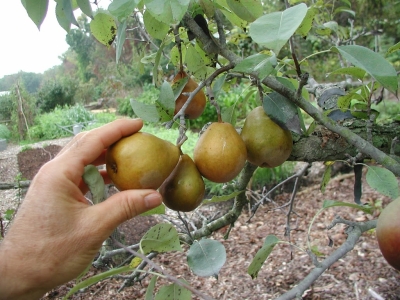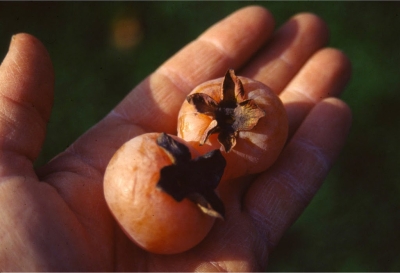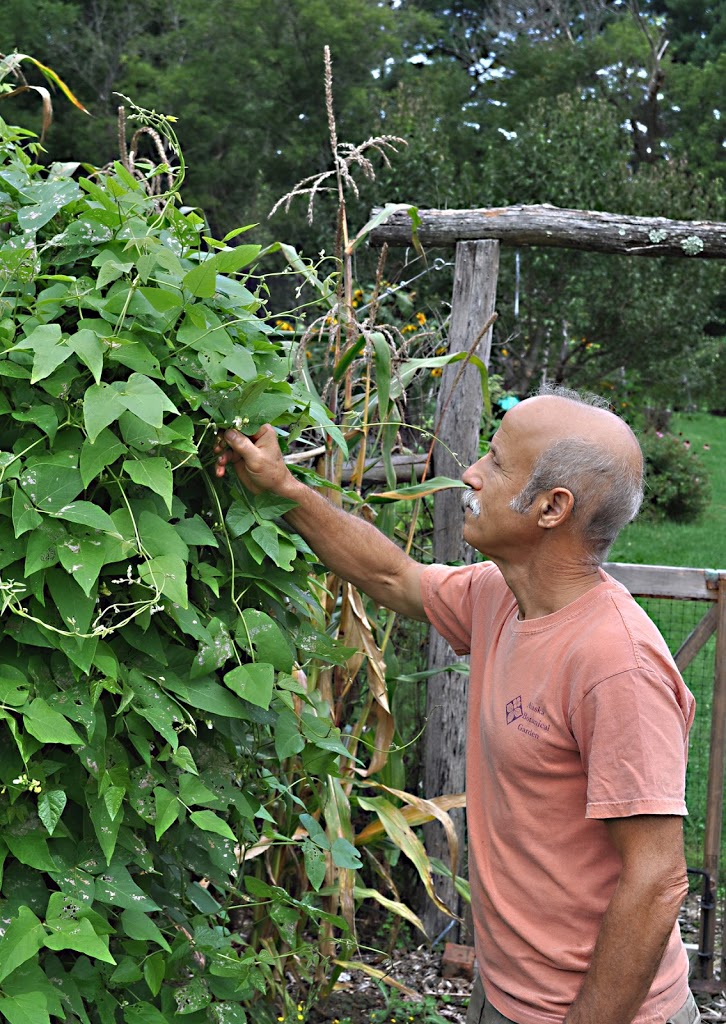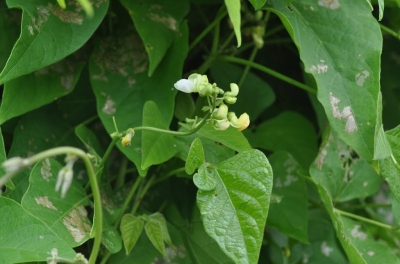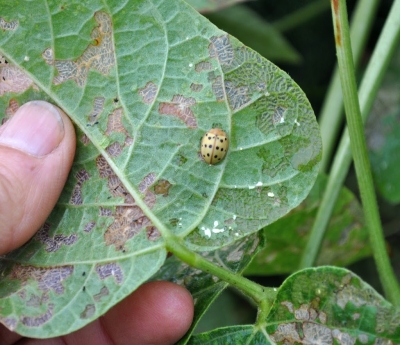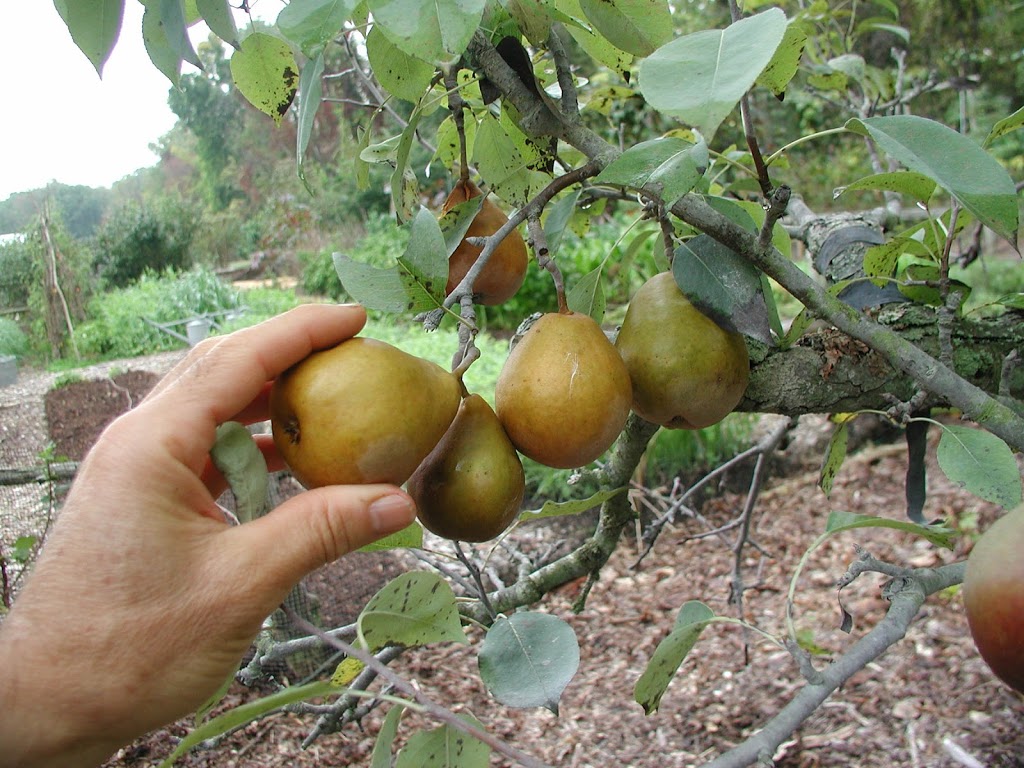Autumn weather has been stellar this year, with a welcome number of crystal clear, sunny days, balmy temperatures, and enough rain to keep plants happy. Imported cabbageworms are evidently also happy, judging from the holes with which broccoli, cauliflower, and cabbage leaves are now riddled. Even worse, looking more closely I see dark, green caterpillar poop down in among the leaves. And even worse than that, all that feeding weakens the plants and — I think — ruins their flavors (even after they’ve been thoroughly washed).
Problems from imported cabbage worms, as well as two other leaf-munching caterpillars, diamondback moth and cabbage looper, are easily dispatched. All three pests are members of the insect order Lepidoptera, which includes moths and butterflies; the organic insecticide B.t., short for Bacillus thuringienses and commercially sold under such trade names as Thuricide and Dipel, kills them while doing essentially no harm to just about everything else, including humans.
So I got out my hand-pumped sprayer this afternoon, measured out enough B.t. to make up a couple of quarts of spray solution, and thoroughly spritzed the cabbage, cauliflower, and broccoli plants. I didn’t bother spraying kale, collards, and Chinese cabbages, which the cabbageworms evidently find less tasty, surely not enough to warrant their spraying.
My other approach to keeping cabbageworms in check is, I find, useful for many perceived gardening problems: Don’t look too closely. This advice may sound counterintuitive because attention to detail and keeping a close eye on plants are earmarks of good husbandry. Perhaps the advice should be restated as “Don’t look too closely if you’re going to panic and think that every hole in a leaf warrants action.” Today, cabbage, cauliflower, and broccoli plants had too many holes.
————————————————–
B.t. is pretty much the only thing I spray on my vegetables and, as I said, only on cabbage and its kin. It’s derived from a naturally-occurring bacteria that lives in the soil, first discovered in 1901 in Japan and used since 1925. Once more potent insecticides, such as DDT, were developed after World War II, “lightweight,” highly specific killers like B.t. fell by the wayside.
B.t. became popular among organic gardeners in the 1970s and, unfortunately, among genetic engineers in the 1980s. During the latter period, scientists developed techniques with which to insert foreign genes into organisms. Insect-resistant tobacco, with B.t. built into its genetics, was developed in 1985 and the first genetically engineered crop plant, potato, was put on the market in 1995. Yummy. (Tobacco and potato — and tomato — fall prey to another lepidopterous caterpillar, the tobacco hornworm.)
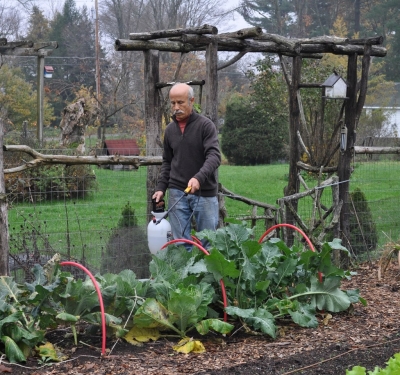
So what’s wrong with genetically engineering plants with built-in resistance to insects? A lot! First of all, pleiotropy. As Carol Deppe states in her excellent book Breed Your own Vegetable Varieties, “pleiotropy is a genetic version of the ancient Taoist understanding that you cannot do just one thing.” Inserting a foreign gene (that is, one that could never have gotten there through natural processes, such as the fish gene that was inserted into tomatoes for cold hardiness) into a plant can have effects beyond the desired primary effect. That secondary effect may be good (unlikely), bad, or neutral in terms of nutrition, health, flavor, and anything else.
But that’s not all. In some cases, plants with built-in B.t. experience increased attacks from insects other than those for which B.t. has effect. Commercially, this has resulted in increased pesticide use to control those other insect pests.
And finally, having whole fields of plants uniformly oozing B.t. to kill lepidopterous predators sets up a Darwinian experiment: A very few of those caterpillars are going to be somewhat resistant to B.t. and over time, they will be the ones that will thrive and multiply. Eventually, then, we’ll have whole armies of caterpillars that can laugh off B.t. and just keep munching away. Which will be bad also for us backyard gardeners.
Here on my farmden, I don’t spray B.t. at the first sign of caterpillar damage. That’s another reason I don’t spray all cabbage kin. I’d like to keep a healthy population of B.t. susceptible caterpillars alive.
————————————————-
The warm, sunny weather has also been a boon to cool weather weeds, especially quackgrass and oxalis. I usually clear and cover with compost any vegetable beds just as soon as I am through with them for the season. Clearing a bed rids it of most perennial weeds and the 1 inch deep icing of more or less weed-free compost snuffs out any small annual or perennial weed roots or seedlings that try to grow. That’s the theory, at least.
This past spring, beds were weedier than usual. I reasoned that weeds were sneaking in during autumn’s warm spells, before weather turned frigid. So this autumn, I waited until this week to clean up most beds and ice them with compost, leaving little time before cold weather for weeds to sneak in. Finally, everything looks neat and pretty.
————————————————-
Pepper, like tomato, cabbage, and some other vegetables, has its caterpillar predators, in this case the corn earworm which, as you may guess, also attacks corn. In decades of growing peppers, damage has never been severe enough to warrant spraying peppers or, for that matter, corn with B.t. for that pest.
My attention turned to peppers this week because a few plants were still green thanks to the blanket over them during recent severe frosts. The pepper plants’ days are numbered though, and the beds need cleaning up, so I pulled the plants but harvested any full-sized fruits. Green peppers are immature, not ripe. Some people enjoy them at this stage; I don’t. If sufficiently mature, though, sound green peppers will ripen, turning yellow, red, or purple, depending on the variety, on a kitchen counter. That’s where mine went.
———————————————–
(Quoting from an old Jimmy Rushing blues song, “there’s a change in the weather, there’s a change in the sea” . . . I’ll say. As I wrote this post, Hurricane Sandy was storming nearer. The weather was still balmy, but with lots of wind and, soon, rain. The landscape swayed. The hurricane took a left turn as it headed up the Hudson Valley and the farmden was spared, experiencing only fairly strong winds and a half an inch of rain. I was ready, though.)
